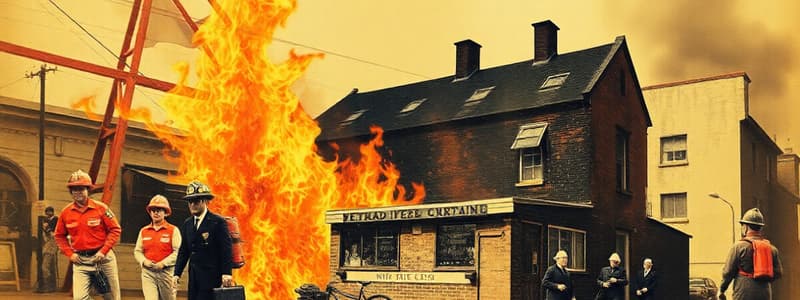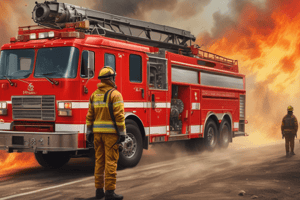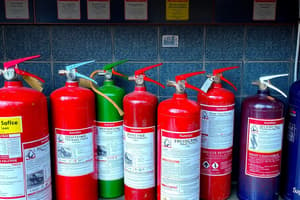Podcast
Questions and Answers
What are the three components of fire?
What are the three components of fire?
- Heat, fuel, and oxygen (correct)
- Water, fuel, and heat
- Oxygen, light, and heat
- Air, heat, and fuel
What is the difference between a Smoldering Fire and a Backdraft?
What is the difference between a Smoldering Fire and a Backdraft?
- A Smoldering Fire is a rapid, flameless combustion, while a Backdraft is a sudden, intense fire that occurs when oxygen is reintroduced into a room
- A Smoldering Fire is a slow, flameless combustion, while a Backdraft is a sudden, intense fire that occurs when oxygen is reintroduced into a room (correct)
- A Backdraft is a rapid, flameless combustion, while a Smoldering Fire is a sudden, intense fire that occurs when oxygen is reintroduced into a room
- A Backdraft is a slow, flameless combustion, while a Smoldering Fire is a sudden, intense fire that occurs when oxygen is reintroduced into a room
What is the process of removing a hazard from a workplace called?
What is the process of removing a hazard from a workplace called?
- Risk Analysis
- Engineering Controls
- Substitution
- Elimination (correct)
What is the most effective way to control a hazard?
What is the most effective way to control a hazard?
What are the four cornerstones of an Emergency Plan?
What are the four cornerstones of an Emergency Plan?
What is the definition of a Near Miss Accident?
What is the definition of a Near Miss Accident?
Which of the following is NOT a type of accident?
Which of the following is NOT a type of accident?
What does the term 'Workplace Violence' refer to?
What does the term 'Workplace Violence' refer to?
What is the term for a situation where a worker is caught between two moving objects?
What is the term for a situation where a worker is caught between two moving objects?
Which of the following is NOT considered a safety practice?
Which of the following is NOT considered a safety practice?
What is the difference between 'Risk Analysis' and 'Risk Control'?
What is the difference between 'Risk Analysis' and 'Risk Control'?
What is the full form of 'OHS'?
What is the full form of 'OHS'?
Why is workplace bullying considered a serious issue?
Why is workplace bullying considered a serious issue?
The Fire Code of the Philippines requires that buildings have fire detection, alarm, systems to notify building occupants in case of emergencies.
The Fire Code of the Philippines requires that buildings have fire detection, alarm, systems to notify building occupants in case of emergencies.
The term 'Standpipe System' refers to a water-sprinkling system that consists of pipes along a ceiling containing water under pressure.
The term 'Standpipe System' refers to a water-sprinkling system that consists of pipes along a ceiling containing water under pressure.
Human trafficking involves the recruitment, transportation, transfer, harboring, or receipt of people through force, fraud, or deception to exploit them for profit.
Human trafficking involves the recruitment, transportation, transfer, harboring, or receipt of people through force, fraud, or deception to exploit them for profit.
The Earth's crust is constantly moving and shifting underneath the surface, causing earthquakes.
The Earth's crust is constantly moving and shifting underneath the surface, causing earthquakes.
The centers for Disease Control and Prevention 'CDC' recommends dropping to the ground on hands and knees during an earthquake.
The centers for Disease Control and Prevention 'CDC' recommends dropping to the ground on hands and knees during an earthquake.
Flashcards
Class A Fire
Class A Fire
Fires involving ordinary combustible materials like paper, wood, and textiles.
Class B Fire
Class B Fire
Fires involving flammable liquids and gases.
Class C Fire
Class C Fire
Fires involving electrical equipment.
Class D Fire
Class D Fire
Signup and view all the flashcards
Class K Fire
Class K Fire
Signup and view all the flashcards
Fire Stages
Fire Stages
Signup and view all the flashcards
Ignition Stage
Ignition Stage
Signup and view all the flashcards
Incipient Stage
Incipient Stage
Signup and view all the flashcards
Growth Stage
Growth Stage
Signup and view all the flashcards
Fully Developed Stage
Fully Developed Stage
Signup and view all the flashcards
Flashover Stage
Flashover Stage
Signup and view all the flashcards
Decay/Burnout Stage
Decay/Burnout Stage
Signup and view all the flashcards
Smoldering Fire
Smoldering Fire
Signup and view all the flashcards
Backdraft
Backdraft
Signup and view all the flashcards
Fire Extinguisher
Fire Extinguisher
Signup and view all the flashcards
Cooling
Cooling
Signup and view all the flashcards
Smothering
Smothering
Signup and view all the flashcards
Starvation
Starvation
Signup and view all the flashcards
Extinguishing Process
Extinguishing Process
Signup and view all the flashcards
Fire Protection Equipment
Fire Protection Equipment
Signup and view all the flashcards
Fire Detection System
Fire Detection System
Signup and view all the flashcards
Sprinkler System
Sprinkler System
Signup and view all the flashcards
Standpipe System
Standpipe System
Signup and view all the flashcards
Study Notes
Fire Safety
- Causes of Fire: Natural (animal, self-ignition), technical (negligence, arson)
- Fire Classifications:
- Class A: Paper, straw, textiles, rubber, plastics
- Class B: Flammable liquids (petrol, diesel, paint), gases (methane, propane)
- Class C: Electrically energized equipment (computers, radios, toasters)
- Class D: Combustible metals (magnesium, aluminum, lithium, sodium, potassium)
- Class K: Cooking appliances involving cooking oils, fats, greases
- Stages of Fire:
- Ignition: All 3 fire components joined
- Incipient: Fire can be extinguished with a fire blanket
- Growth: Incipient fire becomes heat source, nearby fuel ignites
- Fully Developed: Entire area is on fire, temperature reaches 1000°C
- Full Fire: Objects around fire reach ignition temperature
- Flashover: Objects ignite without direct flame contact
- Decay/Burnout: Fuel runs out, oxygen is depleted, fire becomes less intense
- Smoldering: Slow, flameless combustion; temperature can still increase
- Backdraft: Oxygen re-introduced suddenly in enclosed space, may cause fire to re-ignite
- Putting out Fires:
- Cooling: Decreasing burning material temperature
- Smothering: Limiting oxygen supply
- Starvation: Removing fuel source
- Breaking combustion process: Interrupting the chemical reaction
- Fire Protection Equipment:
- Fire detection, alarms, communication systems (for Philippines)
- Sprinkler Systems: Pipes along ceiling with water under pressure
- Standpipe Systems: Piping and hose connections
Earthquakes
- Earthquakes: Sudden ground shaking from seismic waves.
- Human Trafficking: Recruitment, transportation, transfer, harboring, or receipt of people through force, fraud, or deception to exploit them.
Emergency Planning
- Emergency : Any sudden set of circumstances demanding immediate action
- Emergency Response Plan: Integrated policies/procedures to prepare for, respond to, and recover from emergencies
- Cornerstones of an Emergency Plan: Prevention, Preparedness, Response
Occupation Health and Safety
-
Occupation Health and Safety: Recognition, assessment, and control of hazards in work environments
-
Important OHS terms:
- Health: Physical and mental well-being enabling normal job performance
- Safety/Safe: Physical or environmental conditions preventing accidents.
- Work Accident: Unplanned occurrence resulting in injury, property damage, or work interruption (including any combination of those)
- Near miss accidents: Undesired incidents that, under slightly different circumstances, could have resulted in harm, damage, disruption, or their combinations
- Occupational/work injury: Damage from a workplace incident causing cut, fracture, sprain, or amputation
- Occupational illness: Abnormal conditions caused by environmental factors in the workplace
- Loss: Preventable waste of resources from injury or damage.
-
Workplace Hazards: Injuries and diseases from unsafe acts and conditions
-
Unsafe Acts: Employees not adhering to standards or rules.
-
Unsafe Conditions: Physical or chemical properties of materials, machines, or environments which can cause danger
-
Types of Accidents:
- Struck-Against: Worker hits something.
- Struck-By: Worker is hit by something moving.
- Contact-By: Object/agent moves toward worker.
- Contact-With: Worker moves toward object/agent.
- Caught-In: Body part trapped.
- Caught-On: Body part caught by stationary object.
- Caught-Between: Body between two moving/static objects.
- Fall-same-level/Fall-to-Below: Worker slips, trips, or falls.
- Overexertion/Repetitive Stress Injuries: Pushing, pulling, excessive use of muscles.
- Exposure: Unhealthy environmental factors.
Risk Analysis
- Risk Analysis (steps):
- Identify hazards
- Assess probability (chance of event occurring) and consequences (severity of injury) of harm
- Establish risk control measures (elimination, substitution, engineering controls)
- Costs of poor safety management: Fatalities, serious injuries, compensation claims, lost productivity, reduced staff morale.
Studying That Suits You
Use AI to generate personalized quizzes and flashcards to suit your learning preferences.




